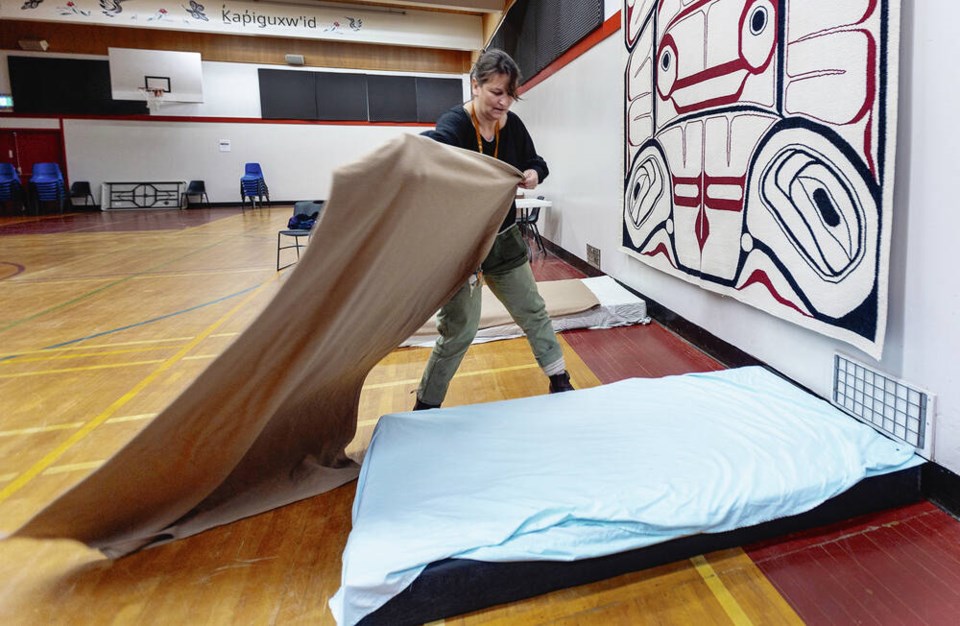Saanich council agreed this week to look into what’s required to create additional shelter spaces and warming centres in the district, after pressure from the City of Victoria to house its own homeless residents rather than sending them downtown.
Victoria had sent letters to Saanich asking the district to establish warming centres for the unhoused during extreme weather events and create additional shelter spaces.
While a number of Saanich councillors indicated they wanted to take immediate action, council instead voted unanimously to have district staff prepare a report on the district’s responsibilities under the Emergency Disaster Management Act and the Assistance to Shelter Act, and what would be required to create new spaces and warming centres.
Coun. Nathalie Chambers conceded the report would be “a start,” but said action is needed now and the district is dragging things out unnecessarily. “We can’t wait for a long time because you know what, if people die on the streets of Saanich, it’s on us because we could have saved them,” she said.
Chambers noted money for warming centres is available through B.C. Housing, while the City of Victoria has a template for an extreme weather response plan.
“I’m extremely grateful to the City of Victoria for doing the lion’s share of this work for a very long time,” she said. “It is incumbent upon us to take care of the vulnerable in this municipality.”
Victoria has complained for years it is doing the heavy lifting to house the homeless during extreme weather, and has challenged neighbouring municipalities to do more.
The city offers 350 year-round shelter spaces, and 73 extreme-weather spaces, while Sooke has 13 and Salt Spring 10.
Victoria also has five potential warming centres that can be activated in an emergency, including Save on Foods Memorial Arena, Fernwood Community Centre, Little Fernwood, Victoria Curling Club and Cook Street Village Activity Centre.
Saanich currently has only the Victoria Native Friendship Centre’s 25 beds, which can expand to 33 in extreme weather.
Coun. Colin Plant said establishing shelter beds is a complex process, but designating warming centres should not be difficult. “We have rec centres, we have buildings that if overtime needs to be paid from our contingency fund to keep people alive, if that’s what we’re talking about, then we should do that,” he said, adding the work needs to happen as soon as possible.
“Turning the heat on in an extreme-cold event and staffing our own facility so people can put their head down and be warm, I think is not unreasonable.”
Mayor Dean Murdock said while the report may not come back to council until 2025 due to staff time constraints, a warming centre could be established before then.
“I don’t want to create unrealistic expectations, but I do think that there is a possibility for us to, through a partner, to have something in place for the cold weather this year,” he said, noting staff have already been in conversation with potential non-profit partners.
Murdock said he understands Victoria’s frustration with carrying the heaviest burden for shelter beds in the region.
“Every municipality in this region has a role to play in this. And I think if we can introduce this conversation in the early part of next year at the regional level, I do think there’s a co-ordination and administrative function that can exist at a regional level where there can be that flow through of funding from B.C. Housing in co-ordination with non-profits who can deliver these services,” he said.
Victoria Coun. Krista Loughton said Saanich’s decision to opt for a report rather than action was disappointing.
“It’s just delaying something that didn’t need to be delayed,” she said. “The warming centre, they could have asked staff to start working on that immediately.”
Loughton said Victoria is at capacity and it’s time other municipalities in the region started to take responsibility for their unhoused population.
“We are inundated and we end up leaving people out in the cold,” she said. “I just want them to have emergency-response plans and that is paid for by [the provincial government], so it doesn’t come out of their budget. This just needs to get started.
“I don’t really want to have adversarial relations with my colleagues in other municipalities, but we’re just really hitting a wall and something needs to be done.”



